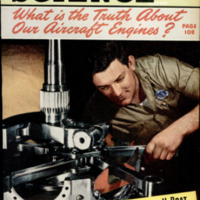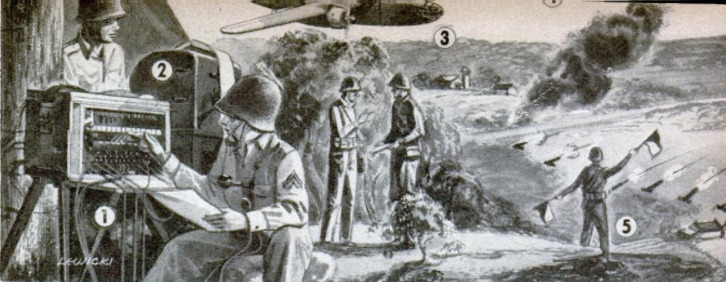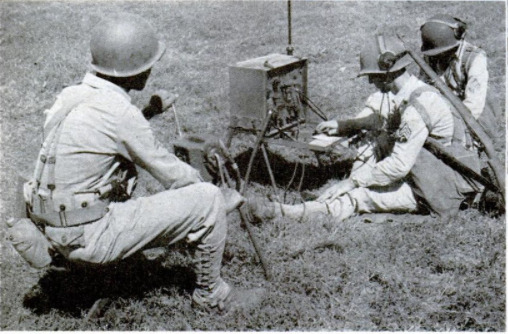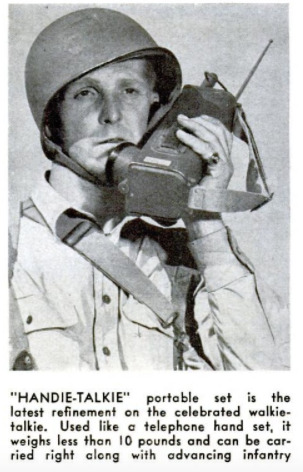-
Title (Dublin Core)
-
Messengers of battle
-
Article Title and/or Image Caption (Dublin Core)
-
Title: Messengers of battle
-
Subtitle: It takes signaling as much as guns to make combat teams invincible
-
extracted text (Extract Text)
-
MODERN war is fought not only
to the chatter of machine guns,
but also to the chatter of teletype
machines. The jingle of a field-tele-
phone bell and the high-pitched,
staccato beeping of a radio code set
are as significant in their way as the
rumble of trucks or the barking
cough of a mortar shell.
For communications have become
the lifeblood of military operations.
An army which had every other
item of equipment for war, yet
lacked wire and radio communica-
tions, would be no better in the fast-
moving warfare of 1943 than a
blind, stupefied giant, stumbling
bravely but hopelessly to defeat and
destruction.
The task of maintaining com-
munications for the U.S. Army is
primarily the job of the Signal Corps;
within that Army the Corps’ func-
tion is roughly that of the nervous
system of a champion athlete. Our
Signal Corps, with its equipment
and men, provides the means by
which information is gathered and
transmitted from every part of the
Army's vast organism to its guid-
ing brain. Then back along the
same channels go orders and in-
structions. Without this interchange
of reflexes and reactions the Army
would not be a living mechanism.
Communications make it a co-ordi-
nated striking force instead of a
disorganized conglomeration of men
and machines working blindly in the
dark. The Signal Corps uses every meth-
od of communication, from the basic device
of having one man walk over to another
and tell him something, right up through
to the most precise and complex develop-
ments of advanced radio technology—de-
velopments which are still held as closely
restricted military secrets.
In between these extremes the Army em-
ploys messengers in vehicles (anything
from a motorcycle or a jeep to an airplane);
wire communication (telephone, telegraph,
and teletype) to the fullest possible ex-
tent; radio transmitters and receivers by
the tens of thousands. Older methods are
by no means forgotten; signal flags and
lights, flares and rockets, cloth panels, all
have their uses at times.
Naturally enough, how-
ever, the most striking Sig-
nal Corps developments |
since 1917-18 have been in.
the field of radio, and here
progress has been excep-
tionally fast in the last few
years. Army experts, work-
ing closely with U. 8. manu-
facturers, have designed and
perfected a whole series of |
special military radios, un-
surpassed by any such
equipment in the world.
Among these is the amaz-
ing “handie-talkie” port-
able set, the latest refine-
ment of the walkie-talkie.
There also is a whole
series of new frequency-modulation radios
of medium range, developed primarily for,
artillery use. These sets may be used by
forward observers to order and direct field-
artillery fire. Other types are employed by
commanding officers to keep in touch with
the batteries in their command net. Voice
transmission has obvious advantages of
speed and flexibility over code for these
uses. FM transmission cuts through static
and local interference.
One of these sets designed for artillery
observers is mounted on a jeep, drawing
power from the car's electrical system
through a converter. But the radio often
must go up where even the jeep cannot fol-
low, so the set can be unshipped and car-
ried forward by hand, using battery power.
One husky man can haul it along, although
it is a rugged outfit weighing about 100
pounds. Another, more elaborate artillery
radio set, mounted in an officers’ command
car, can work a number of prearranged fre-
quency channels and is operated by push
buttons, much like those of a home radio.
Because of the global scope of U. s. mili-
tary operations, all this new Signal Corps
equipment has to be designed to function
equally well in the deserts of North Africa,
the bitter climate of Iceland, or the steam-
ing jungles of the South Pacific. For this
reason, all experimental models are put
through a brutal series of laboratory tests
—in steam rooms, refrigerator chambers,
blasts of sand or dust, showers of water.
After that come field tests, with the equip-
ment mounted in jeeps, trucks, or tanks,
pounding up and down over the worst test
courses the officers can devise.
The outfits that stand up—or that can be
redesigned and rebuilt to stand up—are
ready for anything. But even the best
equipment is subject to breakage, damage,
or failure in the field. The Signal Corps
pays special attention to field maintenance,
and has even planned and built a mobile
repair-shop truck, mounted in a bus body
and accompanied by a 1 1/2-ton cargo truck
towing a trailer.
Skilled technicians can make any type of
repair or adjustment in this shop unit,
which normally carries a crew of eight men
and two drivers. To protect the delicate
meters used, the workshop truck can be
closed up and air-conditioned.
The spectacular development of radio
communication in battle should not blind
us to the continuing importance of older
methods. If there is one thing above all
else that a good signal officer worries about,
dreams of, and battles to maintain, it is ef-
fective wire communication. And the wire-
communication system of 1943 is a vastly
different proposition from that of 1918.
The special advantages of wire over radio
are obvious. As one Signal Corps officer
expressed it:
“With radio, you get the sets, issue them,
and hope for the best. They're wonderful,
of course; we couldn't do without them. But
when you've got a good wire circuit in,
you're not kidding. It gives you direct, in-
stant, and private communication. The
enemy normally can’t pick it up with in-
tercept equipment or triangulate on the
sending source. Atmospheric interference
can’t blot your messages out. Yes, wire
may be hard to maintain, but it's awfully
easy to talk over.”
Wire-laying methods have been greatly
improved. Long experience has shown that
wire lines laid directly along a road are too
easily broken or damaged. Where the dis-
tances are not too great and considerations
of speed mot too pressing, the wire crew
tries to get away from roads altogether
and lay its lines across
country. Any truck
can serve as a wire
carrier, and when the
going gets too tough
even for the hardy
jeep, the crew goes it
on foot.
Where possible,
double circuits are
provided between im-
portant points. To
achieve this, a wire
crew may work its
way over rugged
country, then back
over a somewhat dif-
ferent route, laying
the second line, while
Army business al-
ready is flowing over
the first.
Probably the Army's
one favorite method
of communication is
neither the radio nor
telephone, but the
teletypewriter, which
gives direct private
connection, provides
an identical permanent record of every mes-
sage at both ends, and thus comes as close
as any human device can to eliminating the
possibilities of error.
A good field commander, however, isn’t
likely to waste much time arguing one
method against another. He is a glutton
for communications, and wants all he can
get of every type. His dream of perfect
happiness in this respect is to have all lines
of communication, from radio to carrier
pigeons, laid out in parallel and functioning
with faultless efficiency. It's never been like
that in any battle operation, but you can't
blame a man for wishing.
So far as it can, nevertheless, the Army
tries to back one communication line up
with another, and to give double or triple
protection for vital messages.
In a typical divisional front there will be
teletype, telephone, and radio circuits from
Army to Division HQ, and where possible,
teletypewriter from the rear to the front
echelons of the division itself. Telegraph
lines are laid to the infantry and artillery
commands, and from regiment to battalion
HQ. Phone circuits are laid to the regi-
ments and divisional artillery, and from the
regiments to battalions. The usual arrange-
ment in setting up wire circuits is that the
higher unit takes the responsibility of lay-
ing its wire to the lower (and more ad-
vanced) unit. Telephone exchanges range
from the divisional board, with 60 or 80
connections, to the
regimental field ex-
change, with 12 drops,
and the small battal-
ion board with six.
Radio nets from the
division HQ include
infantry regiments,
artillery battalions,
cavalry reconnais-
sance units, and any
special supporting
troops, such as can-
non company, anti-
tank company, engi-
neers, military police
company, or the like.
Infantry regiments
have radio nets to
their battalions, and
the battalion will have
handie-talkie radio
circuits to its com-
panies.
The total communi-
cations equipment of
a modern division is
a massive setup. The
signal Corps has the
responsibility of in-
stalling and operating all communications
equipment from the top command down
through the regimental echelon. More ad-
vanced units operate their own communica-
tions, but with equipment developed, tested,
and procured for them by the Signal Corps.
No one should get the idea, however, that
Signal Corps men do all their work far be-
hind the battle line. On the contrary, their
service is extremely hazardous; few mili-
tary objectives can expect to receive more
attention from the enemy than communica-
tions crews and installations. The World
War record of the Corps speaks for itself.
Out of a little more than 34,000 officers and
men in the AEF’s Signal Corps, 301 were
killed and 1,721 wounded or gassed. Only
the infantry had a higher percentage of
casualties.
In this war, Signal Corps men are seeing
even more vigorous action. The Corps is
now training members of the Women’s
Army Auxiliary Corps to replace enlisted
men as radio operators and mechanics at
certain Air Forces installations; the men
will thus be freed for front-line duties.
Americans have good reason to take
pride in their Army Signal Corps. This
branch of military service was originated
by us and copied by all the other armies
of the world. Signals—banners or horns
—had been used by armies since the dawn
of history, of course, yet little was done
to organize signaling as a specialized tech-
nique until nearly a generation after the
invention of the telegraph.
The world's first real Signal Corps was
founded in 1860, shortly before the Civil
‘War, when the U. S. Army granted the ap-
pointment and title of Signal Officer to a
young Army surgeon, Major (later Brig-
adier General) Albert J. Myer.
Since then the Corps has continued to
serve the nation in peace and war. Among
its peacetime services was the establish-
ment of the first national weather observa-
tion and forecasting service. No phase of
war has developed more strikingly in mod-
ern times than war communications, and
the Signal Corps has kept pace with that
growth. Its men are serving again now,
true to their terse combat motto: “Get the
message through.”
-
Contributor (Dublin Core)
-
John H. Walker (Article Writer)
-
Language (Dublin Core)
-
eng
-
Date Issued (Dublin Core)
-
1943-06
-
pages (Bibliographic Ontology)
-
49-53
-
Rights (Dublin Core)
-
Public Domain (Google Digitized)
-
Archived by (Dublin Core)
-
Matteo Ridolfi
-
Marco Bortolami (editor)
 Popular Science Monthly, v. 142, n. 6, 1943
Popular Science Monthly, v. 142, n. 6, 1943








